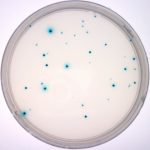According to the Modern Synthesis of Evolution mutational events occur spontaneously and are considered random in respect to the potential outcome they might inflict on the organism. In other words, beneficial mutations could not be directly selected, but they occur by chance and are filtered by natural selection. For instance, the presence of an antibiotic does not direct mutations to genes that are related to antibiotic resistance. Instead, mutations occur prior to the bacterial contact with the antibiotic and the resistant mutants are then selected by the presence of the antibiotic in the medium.
However, in the last 30 years several studies came forward suggesting the existence of a mutation category that escapes the standards set by classical natural selection – the so called “adaptive mutation”. Studies with microorganisms has shown that adaptive mutations are related to non-lethal phenotypes, such as the ability to grow with an alternative carbon source. Bacteria that cannot use a certain carbon source evolve to accumulate mutations in genes that would allow the use of this particular nutrient. The novelty is that most of these mutations occur when the bacteria are exposed to the carbon source. The mechanism by which adaptive mutations occur is not yet clear, and is still being vigorously debated in the scientific community.
In this project, we investigate the nature of adaptive mutations using as a model the selection of PHO-constitutive mutants (these are mutants that express genes related to phosphate assimilation irrespective of phosphate concentration in the environment). These mutants are selected in a medium containing glycerol-2-phosphate (G2P) as the sole carbon source. We analyze several aspects of PHO-constitutive mutations, such as:
-
Kinetics of accumulation of the mutants
-
Molecular identification of the mutations
-
Genes and proteins that increase or inhibit the appearance of PHO mutants
-
Stability of the mutations
-
Environmental conditions that might affect the emergence of PHO mutants
Our ultimate goal is to characterize the process of emergence of PHO-constitutive mutations and to determine the mechanism through which these mutations occur.
